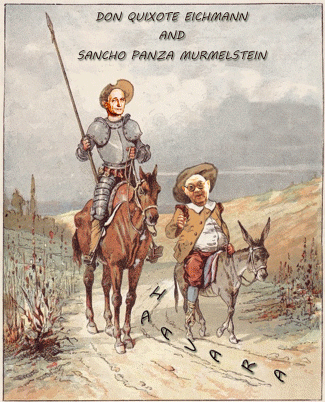Sancho Panza, by Wikipedia
SANCHO PANZA
by Wikipedia
December 18, 2014
NOTICE: THIS WORK MAY BE PROTECTED BY COPYRIGHT
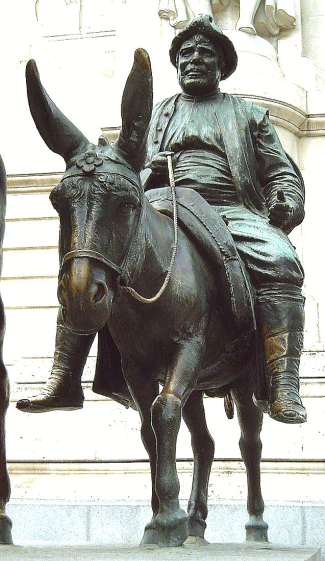
Statue of Sancho Panza in Madrid (Lorenzo Coullaut Valera, 1930).
Created by: Miguel de Cervantes
Portrayed by: Man of La Mancha (play)
Gender: Male
Occupation: Peasant / Squire
Title: Hidalgo
Spouse(s): Teresa Cascajo Panza
Children María Sancha Panza, Sanchico
Religion: Roman Catholic
Nationality: Spanish
Sancho Panza [ˈsantʃo ˈpanθa] is a fictional character in the novel Don Quixote written by Spanish author Don Miguel de Cervantes Saavedra in 1605. Sancho acts as squire to Don Quixote, and provides comments throughout the novel, known as sanchismos, that are a combination of broad humour, ironic Spanish proverbs, and earthy wit. "Panza" in Spanish means "belly" (cf. English "paunch," Italian "pancia", several Italian dialects "panza").
Don Quixote
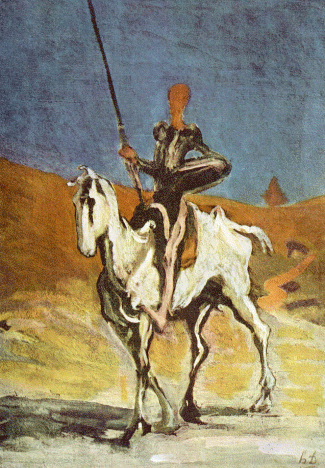
Honoré Daumier − Don Quichotte und Sancho Panza (c. 1868)
Before a fit of madness turned Alonso Quijano into Don Quixote, Sancho Panza was indeed his servant. When the novel begins Sancho has been married for a long time to a woman named Teresa Cascajo[1] and has a daughter, María Sancha (also named Marisancha, Marica, María, Sancha and Sanchica), who is said to be old enough to be married. Sancho's wife is described more or less as a feminine version of Sancho, both in looks and behaviour. When Don Quixote proposes Sancho to be his squire, neither he nor his family strongly oppose it.
Sancho is illiterate and proud of it but by influence of his new master he develops considerable knowledge about some books. Sancho instead provides the earthly wisdom of Spanish proverbs, surprising his master. During the travels with Don Quixote he keeps contact with his wife by dictating letters addressed to her.
Sancho Panza offers interpolated narrative voice throughout the tale, a literary convention invented by Cervantes. Sancho Panza is precursor to "the sidekick," and is symbolic of practicality over idealism. Sancho is the everyman, who, though not sharing his master's delusional "enchantment" until late in the novel, remains his ever-faithful companion realist, and functions as the clever sidekick. Salvador de Madariaga detected that, as the book progresses, there is a "Quixotization" of Sancho and a "Sanchification" of Don Quixote, so much that, when the knight recovers sanity on his deathbed, it is Sancho who tries to convince him to become pastoral shepherds.
In the novel, Don Quixote comments on the historical state and condition of Aragón and Castilla, which are vying for power in Europe. Sancho Panza represents, among other things, the quintessentially Spanish brand of skepticism of the period.
Sancho obediently follows his master, despite being sometimes puzzled by Quixote's actions. Riding a donkey, Dapple, he helps Quixote get out of various conflicts while looking forward to rewards of aventura that Quijote tells him of.
Don Quixote, Part Two
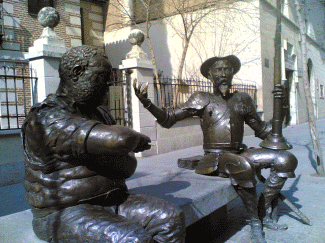
Bronze statues of Sancho Panza (L) and Don Quijote (R) at the Cervantes Birth Place Museum
Sancho's name
Cervantes variously names Sancho in the first book Sancho Zancas (legs); however, in the second book he standardizes Sancho's name in reply to the "false" Avellaneda Quixote sequel. At one point, Sancho alludes to the "false" Avellaneda book by addressing his wife (standardized as Teresa Panza) using the wrong name. The Sancho name does not change, but he calls his wife various names throughout the first part of the volume, and her 'true' name is not revealed until almost the end of that portion of the novel.
The promised insula
Don Quixote promises Sancho the governance of an ínsula, or island. However, Sancho has never heard of this word before, and does not know its meaning. Sancho has long been expecting some vague but concrete reward for this adventure, and believes the word to signify the prize that will make the trouble he has been enduring worthwhile.
The two later encounter a duke and duchess who pretend to make Sancho governor of a fictional fief, la ínsula Barataria (roughly "Isle Come-cheaply"; see Cockaigne). He eagerly accepts, and leaves his master. In a letter, Don Quixote gives Sancho provincial advice on governorship gleaned from the romances he has read, thought to have been inspired by the Diálogo de Mercurio y Carón attributed to Alfonso de Valdés. Quixote's simplistic and romantic understanding of government may have been the author using the allegorical ínsula to satirize the lack of practical learning on the part of philosopher-doctors' placed in positions of power.
The Duke's servants are instructed to play several pranks upon Sancho. Surprisingly, Sancho is able to rule justly (mostly), applying common (if occasionally inconsistent) sense and practical wisdom in spite of, or because of simplistic advice that Don Quixote has read about. As Sancho is abused in these staged parodies he learns how difficult it is to rule and "resigns" to rejoin Don Quixote and continue the adventure.
Ricote
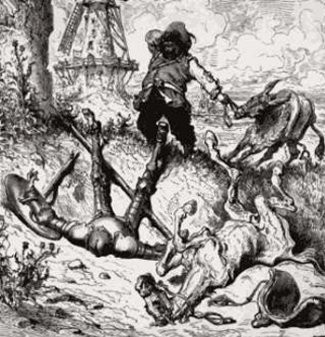
Sancho laments the fall of his master.
Sancho encounters Ricote ("fat cat"), his former Morisco neighbor, who has buried a small fortune. Ricote, like all Moriscos, was expelled from Spain and has returned in disguise to retrieve the treasure he left behind. He asks Sancho for his help. Sancho, while sympathetic, refuses to betray his king.
When Don Quixote takes to his deathbed, Sancho tries to cheer him. Sancho idealistically proposes they become pastoral shepherds and thus becomes 'Quixotized'.
Other appearances of the character
Broadway musical
In addition to stage and screen adaptations of the novel itself, Sancho Panza is a major character in the play within a play in the Broadway musical Man of La Mancha, and in the film of the same name. In Man of La Mancha, the newly imprisoned Cervantes recruits his fellow prisoners to portray characters from his novel, with Cervantes himself playing Don Quixote. In the musical, Sancho sings in duet with Quixote, and solos in the song "A Little Gossip." Actors who have played Sancho in the play include Irving Jacobson (who also sang on the original cast album), Tony Martinez (1977 and 1992 revivals), and Ernie Sabella (2002 revival). James Coco played the character in the 1972 film.
Ship
Sancho Panza of Boston was an 1855 medium clipper ship of 876 tons, built in Medford, MA by Samuel Lapham, and owned by John E. Lodge & Co. The ship was renamed Nimrod in 1863, upon sale to British owners, resold to German owners, and re-rigged as a bark. Sancho Panza was bound for Liverpool, having left Pictou, N.S. on Oct. 31, 1890, but was not heard from again.[2]
Notes
1. Also known as Teresa Panza and Sancha, a probable nickname derived from her husband's name. Later in the book, though, she is sometimes named Juana Gutiérrez, in an example of continuity failure.
2. Gleason, Hall (1937). Old Ships and Ship-Building Days of Medford. Medford, MA: J.C. Miller. p. 78.
3. "Impacting into the asteroid - Don Quijote concept". ESA NEO. Retrieved 22 September 2010.
by Wikipedia
December 18, 2014
NOTICE: THIS WORK MAY BE PROTECTED BY COPYRIGHT
YOU ARE REQUIRED TO READ THE COPYRIGHT NOTICE AT THIS LINK BEFORE YOU READ THE FOLLOWING WORK, THAT IS AVAILABLE SOLELY FOR PRIVATE STUDY, SCHOLARSHIP OR RESEARCH PURSUANT TO 17 U.S.C. SECTION 107 AND 108. IN THE EVENT THAT THE LIBRARY DETERMINES THAT UNLAWFUL COPYING OF THIS WORK HAS OCCURRED, THE LIBRARY HAS THE RIGHT TO BLOCK THE I.P. ADDRESS AT WHICH THE UNLAWFUL COPYING APPEARED TO HAVE OCCURRED. THANK YOU FOR RESPECTING THE RIGHTS OF COPYRIGHT OWNERS.
Don Quixote Eichmann and Sancho Panza Murmelstein, by Tara Carreon
[Benjamin Murmelstein] I'd compare myself to Sancho Panza!
-- The Last of the Unjust, directed by Claude Lanzmann -- Illustrated Screenplay

Statue of Sancho Panza in Madrid (Lorenzo Coullaut Valera, 1930).
Created by: Miguel de Cervantes
Portrayed by: Man of La Mancha (play)
Gender: Male
Occupation: Peasant / Squire
Title: Hidalgo
Spouse(s): Teresa Cascajo Panza
Children María Sancha Panza, Sanchico
Religion: Roman Catholic
Nationality: Spanish
Sancho Panza [ˈsantʃo ˈpanθa] is a fictional character in the novel Don Quixote written by Spanish author Don Miguel de Cervantes Saavedra in 1605. Sancho acts as squire to Don Quixote, and provides comments throughout the novel, known as sanchismos, that are a combination of broad humour, ironic Spanish proverbs, and earthy wit. "Panza" in Spanish means "belly" (cf. English "paunch," Italian "pancia", several Italian dialects "panza").
Don Quixote

Honoré Daumier − Don Quichotte und Sancho Panza (c. 1868)
Before a fit of madness turned Alonso Quijano into Don Quixote, Sancho Panza was indeed his servant. When the novel begins Sancho has been married for a long time to a woman named Teresa Cascajo[1] and has a daughter, María Sancha (also named Marisancha, Marica, María, Sancha and Sanchica), who is said to be old enough to be married. Sancho's wife is described more or less as a feminine version of Sancho, both in looks and behaviour. When Don Quixote proposes Sancho to be his squire, neither he nor his family strongly oppose it.
Sancho is illiterate and proud of it but by influence of his new master he develops considerable knowledge about some books. Sancho instead provides the earthly wisdom of Spanish proverbs, surprising his master. During the travels with Don Quixote he keeps contact with his wife by dictating letters addressed to her.
Sancho Panza offers interpolated narrative voice throughout the tale, a literary convention invented by Cervantes. Sancho Panza is precursor to "the sidekick," and is symbolic of practicality over idealism. Sancho is the everyman, who, though not sharing his master's delusional "enchantment" until late in the novel, remains his ever-faithful companion realist, and functions as the clever sidekick. Salvador de Madariaga detected that, as the book progresses, there is a "Quixotization" of Sancho and a "Sanchification" of Don Quixote, so much that, when the knight recovers sanity on his deathbed, it is Sancho who tries to convince him to become pastoral shepherds.
In the novel, Don Quixote comments on the historical state and condition of Aragón and Castilla, which are vying for power in Europe. Sancho Panza represents, among other things, the quintessentially Spanish brand of skepticism of the period.
Sancho obediently follows his master, despite being sometimes puzzled by Quixote's actions. Riding a donkey, Dapple, he helps Quixote get out of various conflicts while looking forward to rewards of aventura that Quijote tells him of.
Don Quixote, Part Two

Bronze statues of Sancho Panza (L) and Don Quijote (R) at the Cervantes Birth Place Museum
Sancho's name
Cervantes variously names Sancho in the first book Sancho Zancas (legs); however, in the second book he standardizes Sancho's name in reply to the "false" Avellaneda Quixote sequel. At one point, Sancho alludes to the "false" Avellaneda book by addressing his wife (standardized as Teresa Panza) using the wrong name. The Sancho name does not change, but he calls his wife various names throughout the first part of the volume, and her 'true' name is not revealed until almost the end of that portion of the novel.
The promised insula
Don Quixote promises Sancho the governance of an ínsula, or island. However, Sancho has never heard of this word before, and does not know its meaning. Sancho has long been expecting some vague but concrete reward for this adventure, and believes the word to signify the prize that will make the trouble he has been enduring worthwhile.
The two later encounter a duke and duchess who pretend to make Sancho governor of a fictional fief, la ínsula Barataria (roughly "Isle Come-cheaply"; see Cockaigne). He eagerly accepts, and leaves his master. In a letter, Don Quixote gives Sancho provincial advice on governorship gleaned from the romances he has read, thought to have been inspired by the Diálogo de Mercurio y Carón attributed to Alfonso de Valdés. Quixote's simplistic and romantic understanding of government may have been the author using the allegorical ínsula to satirize the lack of practical learning on the part of philosopher-doctors' placed in positions of power.
The Duke's servants are instructed to play several pranks upon Sancho. Surprisingly, Sancho is able to rule justly (mostly), applying common (if occasionally inconsistent) sense and practical wisdom in spite of, or because of simplistic advice that Don Quixote has read about. As Sancho is abused in these staged parodies he learns how difficult it is to rule and "resigns" to rejoin Don Quixote and continue the adventure.
Ricote

Sancho laments the fall of his master.
Sancho encounters Ricote ("fat cat"), his former Morisco neighbor, who has buried a small fortune. Ricote, like all Moriscos, was expelled from Spain and has returned in disguise to retrieve the treasure he left behind. He asks Sancho for his help. Sancho, while sympathetic, refuses to betray his king.
When Don Quixote takes to his deathbed, Sancho tries to cheer him. Sancho idealistically proposes they become pastoral shepherds and thus becomes 'Quixotized'.
Other appearances of the character
Broadway musical
In addition to stage and screen adaptations of the novel itself, Sancho Panza is a major character in the play within a play in the Broadway musical Man of La Mancha, and in the film of the same name. In Man of La Mancha, the newly imprisoned Cervantes recruits his fellow prisoners to portray characters from his novel, with Cervantes himself playing Don Quixote. In the musical, Sancho sings in duet with Quixote, and solos in the song "A Little Gossip." Actors who have played Sancho in the play include Irving Jacobson (who also sang on the original cast album), Tony Martinez (1977 and 1992 revivals), and Ernie Sabella (2002 revival). James Coco played the character in the 1972 film.
Ship
Sancho Panza of Boston was an 1855 medium clipper ship of 876 tons, built in Medford, MA by Samuel Lapham, and owned by John E. Lodge & Co. The ship was renamed Nimrod in 1863, upon sale to British owners, resold to German owners, and re-rigged as a bark. Sancho Panza was bound for Liverpool, having left Pictou, N.S. on Oct. 31, 1890, but was not heard from again.[2]
Notes
1. Also known as Teresa Panza and Sancha, a probable nickname derived from her husband's name. Later in the book, though, she is sometimes named Juana Gutiérrez, in an example of continuity failure.
2. Gleason, Hall (1937). Old Ships and Ship-Building Days of Medford. Medford, MA: J.C. Miller. p. 78.
3. "Impacting into the asteroid - Don Quijote concept". ESA NEO. Retrieved 22 September 2010.
